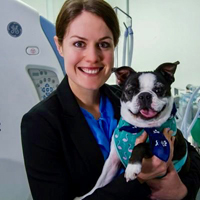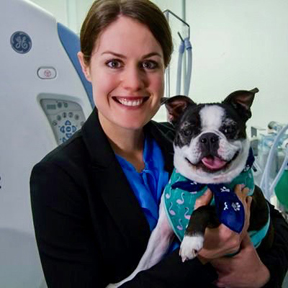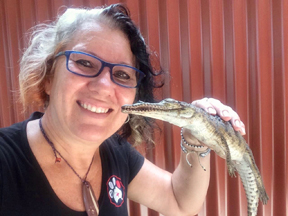
Dr. Bronwyn Orr

RSPCA Australia photo
Dr. Bronwyn Orr, shown holding a rescue pug, recommends that veterinarians have a protocol for handling injured wildlife that are brought to their clinics.
An unpleasant experience with injured wildlife four years ago left a lasting impression on Dr. Bronwyn Orr, an Australian veterinarian and academic. Unbeknownst to her, someone had walked into the reception area of the clinic where she worked in rural northern Queensland carrying a small cardboard box.
Inside was a little magpie with an injured wing.
The box was taken by a nurse, who placed it in the back of a cage in a corner among some kennels, without a note. In the hustle and bustle of a busy country clinic, the box and its delicate contents soon were forgotten.
It took about two days for Orr to find the weak, dehydrated bird and to raise the alarm. The animal had to be euthanized.
"Everyone was so busy and just ignored it," she said. "We didn't have a system to deal with injured wildlife, and we actually forgot about a patient."
A few years later, Orr decided to make the treatment of wildlife a centerpiece of her master of science degree, for which she studied part-time by correspondence through the University of Edinburgh. The results of her thesis, recently published in the Australian Veterinary Journal, indicate that her experiences in Queensland were far from unusual.
Australian practices on average see five to 10 injured native animals every week, Orr's research found. The estimate was based on the survey responses of 132 clinics across the country. When extrapolated nationwide, the data indicate that veterinarians in Australia collectively see between 177,580 and 355,160 wildlife cases each year.
Slightly more than half of injuries — 51 percent — are related to vehicular trauma. Another 22 percent relate to other forms of trauma. Neonatal or orphaned cases accounted for 13 percent of the wildlife cases presented to veterinarians, while 9 percent related to predation, 3 percent to disease and 2 percent to "other."
Survey takers were asked what "most commonly" became of the animals. The answers: 54 percent said animals were cared for by wildlife rehabilitators; 33 percent said the animals were euthanized; 10 percent said the animals were given medical treatment or surgery; 2 percent said the animals were referred to a wildlife hospital; and 1 percent said they were released immediately.
Twenty percent of respondents said they examined the animals immediately upon presentation, while 74 percent said they attended to wildlife only when they had spare time.
Not surprisingly, a lack of resources was cited as veterinarians' biggest impediment to providing care. When they treated wildlife, 90 percent did it for free, Orr's research found. The remaining 10 percent received less than AU$1,000 (US$703) in compensation each year, mostly from donations.
Those findings chime with the results of a survey conducted in 2015 by the British Veterinary Association: An estimated 84 percent of veterinarians in the United Kingdom give their free time to work with animal shelters and charities to treat abandoned, mistreated or injured animals. That study did not consider wildlife explicitly, however.
The United States has a network of wildlife rehabilitators — including some veterinarians and veterinary technicians — who are licensed by state and federal fish and wildlife agencies. According to a survey by the National Wildlife Rehabilitators Association, 64,000 birds, 39,000 mammals, and 2,300 herptiles (reptiles and amphibians) were treated by 343 rehabilitators in 2007. Some provide care with little or no financial support.
From crocodiles to Komodo dragons
Dr. Sarah Brett

Photo courtesy of Dr. Sarah Brett
Although she gets little to no financial support for it, Dr. Sarah Brett is committed to rescuing and rehabilitating injured and sick wildlife as part of her veterinary practice. Unfortunately, she was unable to save this juvenile freshwater crocodile, which she found run over on the road.
Over the past 28 years, Dr. Sarah Brett has seen all manner of distressed animals brought through the doors of the Kimberley Vet Centre at Kununurra, a remote town in rugged northwestern Australia.
"We treat some absolutely incredibly fabulous creatures," she said. "I've done everything from crocodiles to Komodo dragons to wedged-tailed eagles."
Helping them hasn't been easy. Brett's is the only clinic between the towns of Broome and Katherine — a distance of about 1,000 miles. Her crew, including one other surgeon and four nurses, typically are busy treating farm dogs. The remaining bulk of conventional patients is spread between pet cats and the odd horse.
"We treat everything pretty much as best we can," Brett said. "I must confess that there are busy days when the wildlife doesn't get priority. But we have always done them."
When veterinarians need help treating wildlife, their options are limited.
Wildlife rehabilitation groups that do pay veterinarians often are dependent on charities, such as the Royal Society for the Prevention of Cruelty to Animals, or donations from local communities. Far less commonly, private zoos or the government might step in, though usually only for a handful of endangered animal species.
Take the koala. Not only is it a threatened species, it's also a cute and cuddly-looking Australian cultural icon. Consequently, treatment centers, known as "koala hospitals," can attract government funds.
"If you happen to come across a sick or injured koala in Queensland, one of the wildlife hospitals will actually pay to fly it down to their hospital for treatment," Orr said. "But if you were to find another endangered and injured wild animal in that same location, that same support won't be there."
Not be to deterred, the Kimberley Vet Centre in 2000 established an incorporated body for the specific purpose of attracting funding to treat wildlife. It discovered that in order to qualify for charity status under Australian rules, it also had to treat abandoned domestic animals. So it helps them, too.
To scrape up funding, Brett said the body mostly tries to raise funds locally; contributions are patchy. The group once was able to get a community grant from the local shire, but that was years ago.
"For a rare purple-arsed rockhopper you might be able to get some funding," Brett said, dreaming up a faux exotic animal to make her point. "But for the maintenance and care of common wildlife, there are very, very, very few grants available."
Dr. Orr's tips for treating wildlife
As a result, the group has no budget. "We fundraise every dollar we get, and I heavily discount everything we provide at the Kimberley Vet Centre — drugs and services, and donate all my staff time," she said.
A veterinarian line of defense
Although government support for treating wildlife is scarce, Australian authorities haven't necessarily turned a blind eye to protecting the country's unique fauna — and not just its koalas.
The coordinating body Wildlife Health Australia (WHA) has been working since 2002 to monitor and prevent the spread of wildlife diseases, and veterinarians are very much part of the act. Core funding for WHA is provided by federal and state governments, with in-kind support from zoos, universities and veterinary practices.
One WHA initiative, the Sentinel Clinic Wildlife Disease Surveillance Program, has signed up eight veterinary clinics across Australia to monitor disease incidents among native animals.
Participating practices receive a small amount of funding support, according to WHA's Keren Cox-Witton, although the money is not provided specifically for treating sick animals. "It covers the extra work to report to WHA every month about the wildlife cases they're seeing," Cox-Witton explained, "although some clinics do use the funds for more in-depth disease investigations."
Emerging and zoonotic diseases are of obvious interest, as are diseases that could hurt Australia's biodiversity or have an impact on domestic animals.
Recent disease events of concern include heat stress in flying foxes, bobtail flu in shingleback lizards and a facial-tumor disease that's devastating Tasmanian devils. Ongoing endemic diseases include sarcoptic mange in wombats, lorikeet paralysis syndrome, and chlamydia in koalas.
Cox-Witton said WHA would like to add more clinics to the network, resources permitting.
"We recognize that there's a whole other tier of clinics out there where wildlife isn't a significant part of their work but they still see the occasional wildlife case," she said. "That's something that we'd like to look at in the future."
The Kimberley Vet Centre is one of the Sentinel program's latest editions, having signed up in February 2018. Other members include the RSPCA Queensland Wildlife Hospital in Brisbane, the Adelaide Koala and Wildlife Hospital and Tasmania's Kingston Animal Hospital.
As for getting the financial backing to actually treat animals, Orr suggests practices are best placed to follow Brett's practice of rustling up community support.
"Communities sometimes have fundraisers for local sports teams," Orr said. "Why not hold events to help local vets treat wildlife?"
Another avenue worth pursing, she suggests, are GoFundMe-type online campaigns. These could be especially appropriate for more expensive surgical procedures, such as pinning a broken leg.
Whether they get funding support or not, Orr recommends practices at least try to establish basic protocols for triaging wildlife patients. Doing so could, perhaps, involve appointing an enthusiastic nurse as a wildlife point person.
"With wildlife, at the end of the day, what we're doing is all about being humane, and it's all about animal welfare," Orr said. "So if the animal has got critical injuries and it's not survivable, then the most humane thing to do is euthanize it straight away.
"But the only way you can do that is if you actually look in that box."
This article has been changed to remove a reference to an online resource that is no longer available.